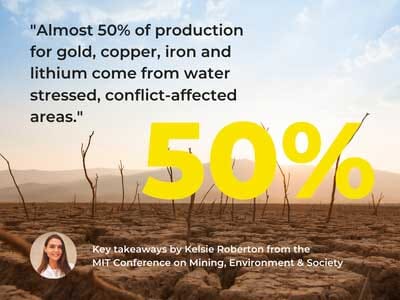
Key Takeaways from the MIT Conference on Mining, Environment and Society

The conference brought together social and natural scientists, policymakers, industry stakeholders, and environmental organisations to examine the conflicting challenges we can expect during the transition from fossil fuels to renewable sources of energy.
It’s a topic that’s at the top of many agendas at the moment, and so it’s helpful to have organisations like the MIT open up opportunities for discussion.
Key Takeaways
The first of the sessions attended on 7th September 2022 was opened by John Fernández, a faculty director of the MIT Environmental Solutions Initiative and a professor of building technology in the MIT Department of Architecture. Fernández introduced the breakdown of the event and was followed by the keynote speaker, Mark Robinson at Extractive Industries Transparency Initiative.
The keynote speech started off by addressing statistical data in the cobalt and lithium mining industry, which revealed that the cobalt market is dominated by the Democratic Republic of Congo, which accounts for roughly 70% of global production.
Following this data, Robinson spoke about the global concern and pressure the mining industry faces when it comes to addressing climate change. Today, almost 50% of production for gold, copper, iron and lithium come from water-stressed, conflict-affected areas. Another issue for the mining industry is the high level of corruption and conflict.
Robinson did note that these sensitivities are not new, and the mining industry must know how to react responsibly and instill strong processes.
‘Strong processes’ could look like legal institutional frameworks, which would depend on effective implementation. Other processes could push for financial institutions to uphold certain standards, following commitments to due diligence that check for governance and corruption risks.
As an Extractive Industries Transparency Initiative (EITI) member, Robinson mentioned the aid that EITI provides as a benchmark on global governance and accountability within industries. Nearly 60 countries and corporations use the EITI framework, providing significant entry points for further data exploration and forward-thinking planning.
Lastly, Robinson highlighted that the current demand boom of low carbon technologies will directly push the market’s need for minerals such as lithium, copper, iron and so on to build electric vehicles and batteries.
Kelsie also attended the session held on 9th September 2022, which highlighted some interesting ideas on how local communities’ knowledge of the land could be used as a systems guide by mining companies to better understand how to work with nature, rather than against it.
Enhancing community rights is a good way to build recognition with local communities and help to found stronger, more trusting relationships. If no local dialogues occur, companies can be at risk of protests, which ultimately become protests against the energy transition itself, slowing down new mining projects and stalling decarbonisation goals.
The keynote speaker, Anthony Bebbington from Ford Foundation, also expressed that the energy transition is a difficult process, and that securing a just transition will be even more of a challenge.
How to balance the Green Transition with a Just Transition is an issue we are deeply engaged with at TDi Sustainability as we advise organisations on how best to build out their green strategies. If you’d like to know more, stay tuned for in-depth discussions that we’ll be inviting you to share in next month.
Sign up to our newsletter to be kept informed about events and research on this topic, and to learn more about how we enable business sustainability at every stage of the value chain.